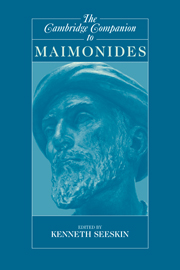Book contents
- Frontmatter
- Introduction
- 1 Moses Maimonides: An Intellectual Portrait
- 2 The Guide and Maimonides’ Philosophical Sources
- 3 Metaphysics and Its Transcendence
- 4 Maimonides’ Epistemology
- 5 Maimonides’ Philosophy of Science
- 6 Maimonides’ Moral Theory
- 7 Maimonides’ Political Philosophy
- 8 Jurisprudence
- 9 Bible Commentary
- 10 Spiritual Life
- 11 Maimonides: Esotericism and Educational Philosophy
- 12 Maimonides--A Guide for Posterity
- Bibliography
- Index
8 - Jurisprudence
Published online by Cambridge University Press: 28 August 2006
- Frontmatter
- Introduction
- 1 Moses Maimonides: An Intellectual Portrait
- 2 The Guide and Maimonides’ Philosophical Sources
- 3 Metaphysics and Its Transcendence
- 4 Maimonides’ Epistemology
- 5 Maimonides’ Philosophy of Science
- 6 Maimonides’ Moral Theory
- 7 Maimonides’ Political Philosophy
- 8 Jurisprudence
- 9 Bible Commentary
- 10 Spiritual Life
- 11 Maimonides: Esotericism and Educational Philosophy
- 12 Maimonides--A Guide for Posterity
- Bibliography
- Index
Summary
THE RATIONAL STRUCTURE OF THE LAW
To appreciate Maimonides' jurisprudence, it is best to begin by looking at how one can be a jurisprudent or halakhist in the normative Jewish tradition. The Talmud notes that “one is not to derive the law from theoretical law [halakhah] or from a particular case [Ma’aseh], but only when they say to him that it is the practical law [halakhah le-ma’aseh, literally, “the law for a case”].” Thus there is theoretical law from which practical law is not to be deduced because it is too general or only hypothetical. Then there is actual lawmaking from what one might call the political lawmaker, which is specific and to which analogies to other laws can usually be made. Finally, there is case law from the rabbinic respondent, which is too particular for one to make analogies to other laws or to simply induce from it what the specific law is. After all, each case might be exceptional.
Maimonides was a lawmaker in all three respects. That is, he was a general theorist, a codifier of specific law, and a casuist who decided the law in particular cases. Nevertheless, when one is seeking Maimonides the philosopher, it is his theoretical contribution that is of most interest.5 Indeed, his philosophical treatment of Jewish law needs to be understood within his overall view of practical reason. One must also see the relation of practical reason to contemplative or metaphysical reason, which is the apex of reason for Maimonides.
- Type
- Chapter
- Information
- The Cambridge Companion to Maimonides , pp. 221 - 244Publisher: Cambridge University PressPrint publication year: 2005
- 2
- Cited by



